Stress Management Diet Slideshow
 |
 |
 |
 |
 |
 |
 |
 |
 |
| home > skin center > skin a-z list > skin problems pictures slideshow article |
Skin Pictures Slideshow: Adult Skin ProblemsMore Slideshows from MedicineNetWatch and learn from these additional pictures slideshows. Skin Cancer Slideshow Insomnia Slideshow Pets & Allergies Slideshow Energy Foods Slideshow See All Slideshows Do you have skin problems?Is your skin itching, breaking out, covered in a rash, or playing host to strange spots? Skin inflammation, changes in texture or color, and spots may be the result of infection, a chronic skin condition, or contact with an allergen or irritant. You can learn to recognize common adult skin problems. Yet, while many are minor, they may signal something more serious, so always consult a doctor for proper diagnosis. 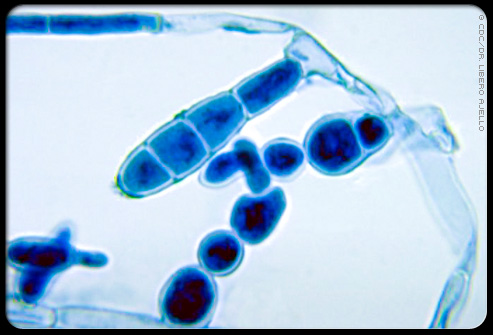
Shingles (herpes zoster)Shingles starts with burning, tingling, or very sensitive skin. A rash of raised dots develops into painful blisters that last about two weeks. Shingles often occurs on the trunk and buttocks, but can appear anywhere. Most people recover, but pain, numbness, and itching linger for many -- and may last for months, years, or the rest of their lives. Treatment with antiviral drugs, steroids, antidepressants, and topical agents can help. 
Hives (urticaria)Hives, a common allergic reaction that looks like welts, are often itchy, stinging, or burning. They may appear anywhere and last minutes or days. Severe hives can cause difficult breathing (get immediate medical attention if this occurs). Medications, foods, or food additives, temperature extremes, and infections like strep throat can cause hives. Removing the trigger often resolves the hives in days or weeks. Antihistamines can provide relief. 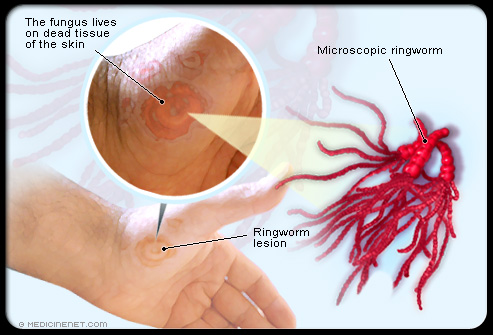
PsoriasisA non-contagious rash of thick red plaques covered with silvery scales, psoriasis usually affects the scalp, elbows, knees, and lower back. The rash can heal and recur throughout life. The cause of psoriasis is unknown, but skin inflammation may be triggering new skin cells to develop too quickly. Treatments include steroid or retinoid creams, light therapy, and medications. 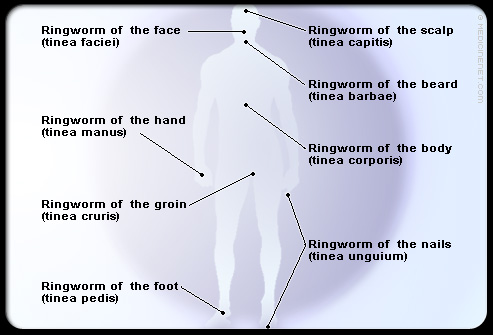
EczemaEczema describes several non-contagious conditions where skin is inflamed, red, dry, and itchy. Stress, irritants (like soaps), allergens, and climate can trigger flare-ups though they are not eczema's cause, which is unknown. In adults, eczema often occurs on the elbows and hands, and in "bending" areas, such as inside the elbows. Treatments include cortisone creams, pills, shots, antibiotics, antihistamines, or phototherapy. 
RosaceaOften beginning as a tendency to flush easily, rosacea causes redness on the nose, chin, cheeks, forehead, even in the eyes. The redness may intensify over time, taking on a ruddy appearance. If left untreated, bumps and pus-filled pimples can develop, with the nose and oil glands becoming bulbous. Rosacea treatment includes medications, as well as surgery to remove blood vessels or correct nose disfigurement. 
Rash from poisonous plantsContact with sap from poison ivy, oak, and sumac causes a rash in most people. It begins with redness and swelling at the contact site, then becomes intensely itchy. Blistering appears within hours or a few days. The typical rash is arranged as a red line on an exposed area, caused by the plant dragging across the skin. The rash usually lasts up to two weeks. 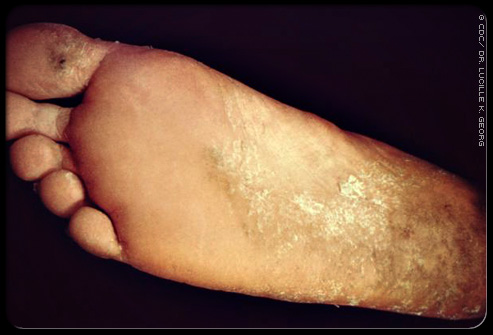
Rash from poisonous plants (cont'd)Prescription or over-the-counter medication may soothe the itching of mild rashes. For a severe rash, oral cortisone may be given. If the skin becomes infected, antibiotics may be necessary. Avoiding direct contact with the plants can prevent the rash, so learn to recognize poisonous plants. In general, poison oak grows west of the Rockies; poison ivy to the east. 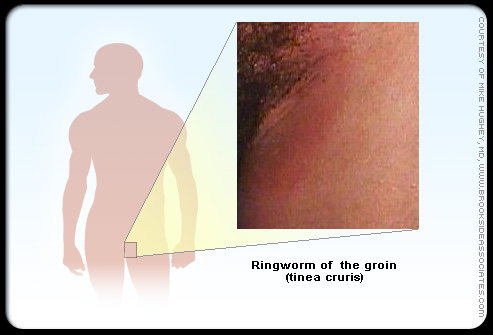
Razor BumpsRazor bumps are tiny, irritated bumps that develop after shaving. The sharp edge of closely shaven hair can curl back and grow into the skin, causing irritation and pimples, and even scarring. To minimize razor bumps, take a hot shower before shaving, shave in the direction of hair growth, and don't stretch the skin while shaving. Rinse with cold water, then apply moisturizer. 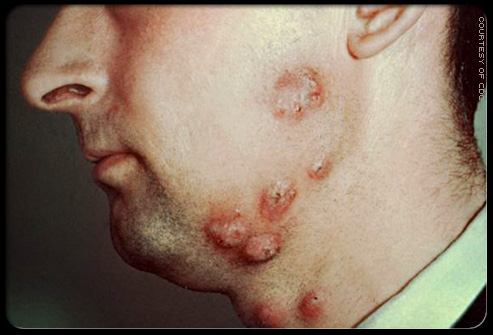
Skin tagsA skin tag is a small flap of flesh-colored or slightly darker tissue that hangs off the skin by a connecting stalk. Usually found on the neck, chest, back, armpits, under the breasts, or in the groin area, skin tags are not dangerous and usually don't cause pain unless they become irritated by clothing or nearby skin rubbing against them. A doctor can remove a skin tag by cutting, freezing, or burning it off. 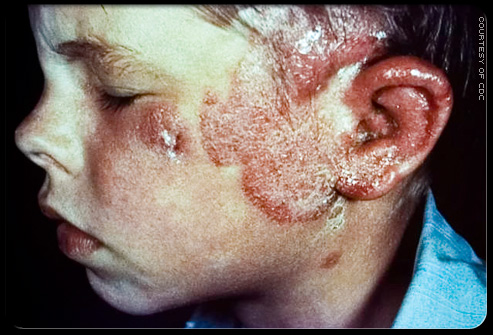
AcneAt the heart of acne lies the pimple -- a plug of fat, skin, and keratin. When open, the plug is called a blackhead, closed, a whitehead. Often seen on the face, chest, and back, acne is caused by many things, including hormones. To help control it, keep oily areas clean and don't squeeze pimples (it may cause infection and scars). Only three medications are proven effective for acne treatment: benzoyl peroxide, retinoids, and antibiotics. 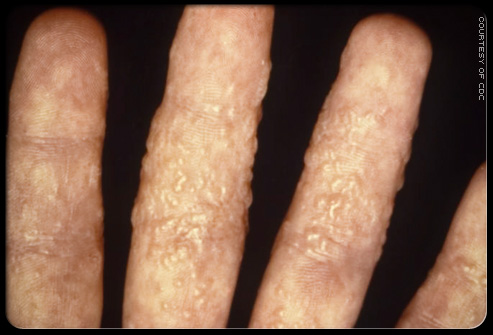
Athlete's footA fungal infection that can cause peeling, redness, itching, burning, and sometimes blisters and sores, athlete's foot is mildly contagious, passed by direct contact or by walking barefoot in areas such as locker rooms, or near pools. The fungi then grow in shoes, especially tight ones without air circulation. It's usually treated with topical antifungal lotions or oral medications for more severe cases. 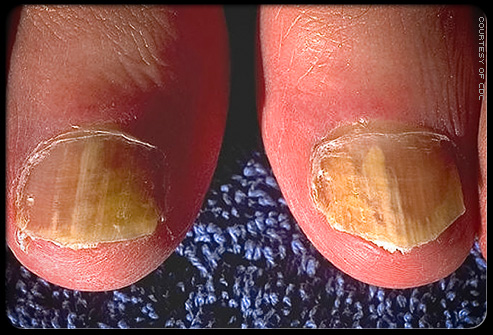
MolesUsually brown or black, moles can be anywhere on the body, alone or in groups, and generally appear before age 20. Some moles (not all) change slowly over the years, becoming raised, developing hair, and/or changing color. While most are non-cancerous, some moles have a higher risk of becoming cancerous. Have a dermatologist evaluate moles that change, have irregular borders, unusual or uneven color, bleed, or itch. 
Age or liver spots (lentigines)These pesky brown spots are not really caused by aging, though they do multiply as you age. They're the result of sun exposure, which is why they tend to appear on areas that get a lot of sun, such as the face, hands, and chest. Bleaching creams, acid peels, and light-based treatments may lessen their appearance. To rule out serious skin conditions such as melanoma, see a dermatologist for proper identification. 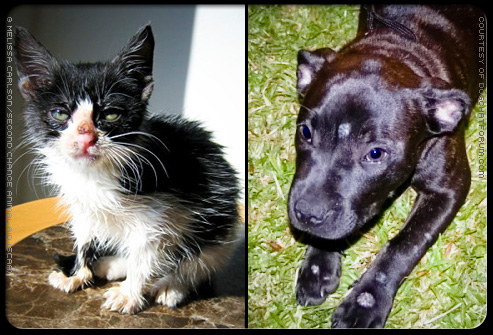
Pityriasis RoseaA harmless rash, pityriasis rosea usually begins with a single, scaly pink patch with a raised border. Days to weeks later, salmon-colored ovals appear on the arms, legs, back, chest, and abdomen, and sometimes the neck. Patches on the back may appear "Christmas tree" shaped. The rash, whose cause is unknown, usually doesn't itch, and often goes away in 6-8 weeks without treatment. 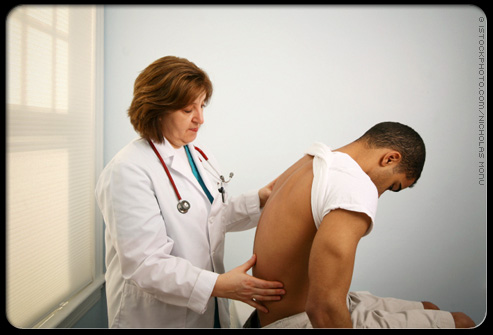
Melasma ('pregnancy mask')Melasma (or chloasma) is characterized by tan or brown patches on the cheeks, nose, forehead, and chin. Although usually called the "pregnancy mask," men can also develop it. Melasma may go away after pregnancy but, if it persists, can be treated with prescription creams and over-the-counter products. Use a sunscreen at all times if you have melasma, as sunlight worsens the condition. 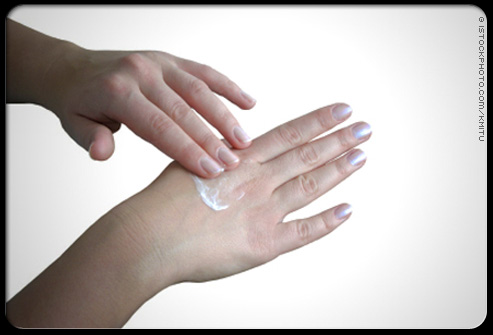
Cold sores (fever blisters)Small, painful, fluid-filled blisters on the mouth or nose, cold sores are caused by the herpes simplex virus. Lasting about seven to 10 days, cold sores are contagious until completely crusted over. Triggers can include fever, too much sun, stress, or menstruation. Antiviral pills or creams can be used as treatment, but call your doctor if sores contain pus, you have a fever greater than 100.5°, or if your eyes become irritated. 
WartsCaused by contact with the contagious human papillomavirus, warts can spread from person to person or via contact with something used by a person with the virus. You can prevent spreading warts by not picking them, covering them with bandages, and keeping them dry. In most cases, warts are harmless, painless, and go away on their own. If they persist, treatments include freezing, surgery, lasers, and chemicals. 
Seborrheic KeratosisNoncancerous growths that may develop with age, seborrheic keratoses can appear on the chest or back, alone, or in groups. They may be dark or multicolored, and usually have a grainy surface that easily crumbles, though they can be smooth and waxy. No treatment is necessary unless irritation develops or their appearance is a concern. Because seborrheic keratoses may be mistaken for moles or skin cancer, see a dermatologist for proper diagnosis. 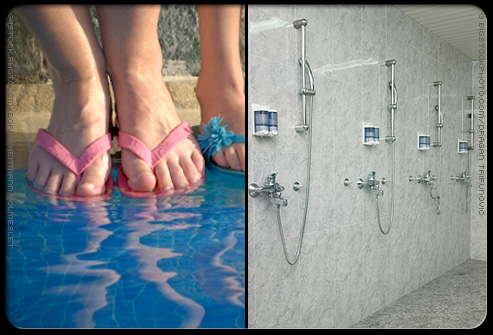
Ringworm (tinea corporis)When fungus affects the skin of the body, it often produces the round spots of classic ringworm. Sometimes, these spots have an "active" outer border as they slowly grow and advance. It is important to distinguish this rash from other even more common rashes, such as nummular eczema. This condition, and others, may appear similar to ringworm, but they are not fungal and require different treatment. BoilsA boil, also referred to as a skin abscess, is a localized infection deep in the skin. A boil generally starts as a reddened, tender area. Over time, the area becomes firm and hard. Eventually, the center of the abscess softens and becomes filled with infection-fighting white blood cells that the body sends via the bloodstream to eradicate the infection. This collection of white blood cells, bacteria, and proteins is known as pus. Finally, the pus "forms a head," which can be surgically opened or spontaneously drain out through the surface of the skin. More Reading on Skin ProblemsAlso see:
|
Health categories: |
Slideshows | Diseases & Conditions | Symptoms & Signs | Procedures & Tests | Medications | Health & Living | News & Views | Medical Dictionary |
Popular health centers: |
Allergies | Arthritis | Cancer | Diabetes | Digestion | Healthy Kids | Heart | Men's Health | Mental Health | Women's Health | More... |
Publications: |
ePublications (PDFs) | XML News via RSS | Audio Podcasts | Email Newsletters |
MedicineNet.com: |
About Us | Privacy Policy | Search Help | Site Map | WebMD® | Medscape® | eMedicine® | eMedicineHealth® | RxList® |
|
©1996-2009 MedicineNet, Inc. All rights reserved. Notices and Legal Disclaimer. |








